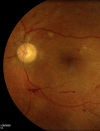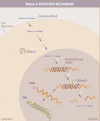Antisense oligonucleotide therapy in diabetic retinopathy
- PMID: 20144342
- PMCID: PMC2769949
- DOI: 10.1177/193229680900300440
Antisense oligonucleotide therapy in diabetic retinopathy
Abstract
Diabetic retinopathy is one of the leading causes of blindness in the United States and other parts of the world. Historically, laser photocoagulation and vitrectomy surgery have been used for the treatment of diabetic retinopathy, including diabetic macular edema. Both procedures have proven to be useful under certain conditions but have their limitations. New pathways and processes that promote diabetic retinopathy have been identified, and several new therapeutic approaches are under investigation. These new therapies may be beneficial in the treatment of diabetic retinopathy and include antivascular endothelial growth factor agents, corticosteroids, and therapies that may potentially target a number of additional diabetic retinopathy-related factors and processes, including antisense oligonucleotides. Second-generation antisense oligonucleotides, such as iCo-007, may offer a significant advantage in the treatment of diabetic retinopathy by downregulating the signal pathways of multiple growth factors that seem to play a critical role in the process of ocular angiogenesis and vascular leakage. Benefits of such molecules are expected to include the specificity of the kinase target and an extended half-life, resulting in less frequent intravitreal drug administration, resistance to molecule degradation, and a good safety profile.
Copyright 2009 Diabetes Technology Society.
Figures




Similar articles
-
Current and Future Pharmacologic Therapies for Diabetic Retinopathy.Curr Pharm Des. 2018;24(41):4903-4910. doi: 10.2174/1381612825666190130140717. Curr Pharm Des. 2018. PMID: 30706803 Review.
-
A multimodal approach to diabetic macular edema.J Diabetes Complications. 2016 Apr;30(3):545-53. doi: 10.1016/j.jdiacomp.2015.11.008. Epub 2015 Nov 14. J Diabetes Complications. 2016. PMID: 26853628 Review.
-
[Diabetic retinopathy].Nihon Rinsho. 2015 Dec;73(12):2032-6. Nihon Rinsho. 2015. PMID: 26666149 Japanese.
-
Advances in the treatment of diabetic retinopathy.Discov Med. 2010 Apr;9(47):363-73. Discov Med. 2010. PMID: 20423681
-
Changing paradigms in the treatment of diabetic retinopathy.Curr Opin Ophthalmol. 2009 Nov;20(6):532-8. doi: 10.1097/ICU.0b013e328330b533. Curr Opin Ophthalmol. 2009. PMID: 19644368 Review.
Cited by
-
Identification and Validation of Autophagy-Related Genes in Diabetic Retinopathy.Front Endocrinol (Lausanne). 2022 Apr 29;13:867600. doi: 10.3389/fendo.2022.867600. eCollection 2022. Front Endocrinol (Lausanne). 2022. PMID: 35574010 Free PMC article.
-
Future Perspectives of Therapeutic, Diagnostic and Prognostic Aptamers in Eye Pathological Angiogenesis.Cells. 2021 Jun 10;10(6):1455. doi: 10.3390/cells10061455. Cells. 2021. PMID: 34200613 Free PMC article. Review.
-
Oligonucleotide therapy: An emerging focus area for drug delivery in chronic inflammatory respiratory diseases.Chem Biol Interact. 2019 Aug 1;308:206-215. doi: 10.1016/j.cbi.2019.05.028. Epub 2019 May 25. Chem Biol Interact. 2019. PMID: 31136735 Free PMC article. Review.
-
RNA interference-based therapy for spinocerebellar ataxia type 7 retinal degeneration.PLoS One. 2014 Apr 23;9(4):e95362. doi: 10.1371/journal.pone.0095362. eCollection 2014. PLoS One. 2014. PMID: 24759684 Free PMC article.
-
In vivo delivery of cell-permeable antisense hypoxia-inducible factor 1α oligonucleotide to adipose tissue reduces adiposity in obese mice.J Control Release. 2012 Jul 10;161(1):1-9. doi: 10.1016/j.jconrel.2012.04.026. Epub 2012 Apr 23. J Control Release. 2012. PMID: 22546680 Free PMC article.
References
-
- Henry SP, Miner RC, Drew WL, Fitchett J, York-Defalco C, Rapp LM, Levin AA. Antiviral activity and ocular kinetics of antisense oligonucleotides designed to inhibit CMV replication. Invest Ophthalmol Vis Sci. 2001;42(11):2646–2651. - PubMed
-
- Ciulla TA, Amador AG, Zinman B. Diabetic retinopathy and diabetic macular edema. Diabetes Care. 2003;26(9):2653–2664. - PubMed
-
- Duh E. Diabetic retinopathy. Totowa (NJ): Humana Press; 2008.
-
- Fong DS, Aiello LP, Ferris FL, 3rd, Klein R. Diabetic retinopathy. Diabetes Care. 2004;27(10):2540–2553. - PubMed
-
- Meyerle CB, Chew EY. Duh E, editor. Diabetic retinopathy. Totowa (NJ): Humana Press; 2008. Ferris FL 3rd. Nonproliferative diabetic retinopathy; pp. 4–10.
Publication types
MeSH terms
Substances
LinkOut - more resources
Full Text Sources
Other Literature Sources
Medical

